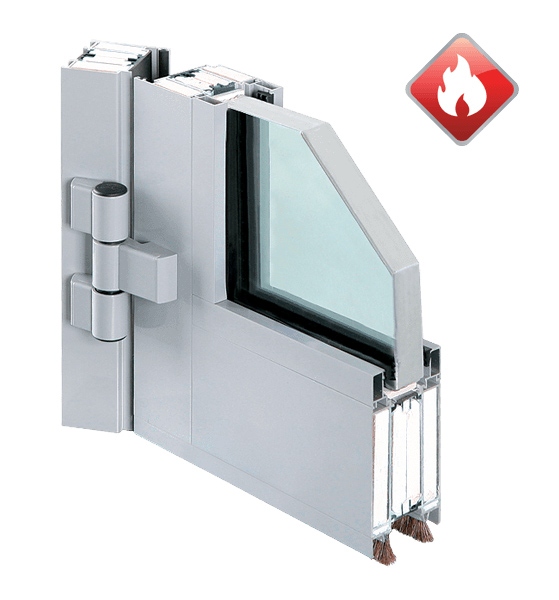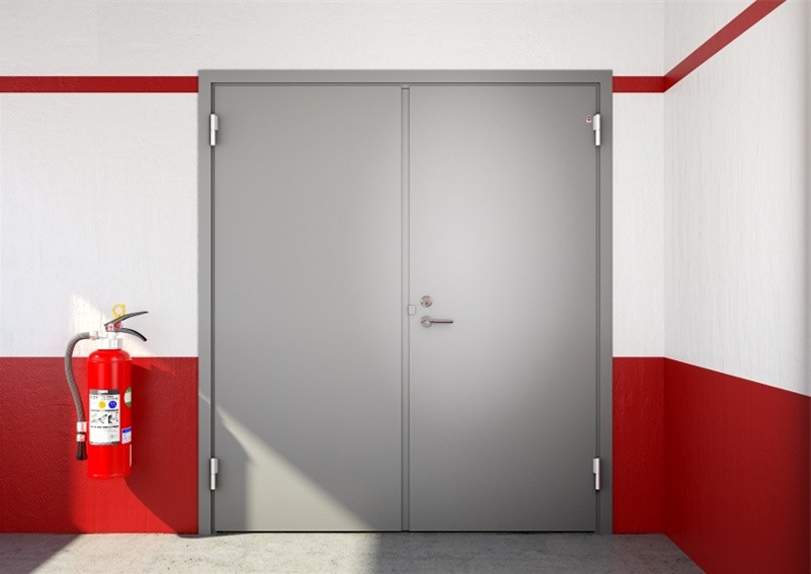Fire rated doors are a special type of door that is distinctly different from the ordinary doors we usually encounter at home or work. The main purpose of fire doors is to provide a safe exit from the building in case of emergencies, such as a fire.
Since people’s lives literally depend on the quality, properties, and resistance to external factors of such doors, fire rated doors are thoroughly tested to meet safety standards and are made of solid materials, which in the case of a fire gives people extra time to successfully leave the building or wait for help.
That’s why, when looking for a suitable fire door, special attention should be paid to its specifications in order to ensure both its functionality and safety.
The main task of the fire rated doors is to protect against smoke, fire, and extreme temperatures. Such a door is something like a whole system that also includes the door, frame, glazing, etc. Each of these should be carefully checked and must comply with safety standards. Once all components have been tested, they are marked as certified for use in fire doors assembly. Also in some cases, the components that make up the door may be tested altogether instead of being individually checked, to get the fire rating.
During the process, fire doors are tested according to several standards. The main ones are NFPA 252, UL10B, and UL10C. Here fire rated door specifications are evaluated for fire resistance and in some cases for its ability to withstand high pressure (for example, when extinguishing a fire with a hose stream). Although some types of doors may not be required to be checked via high water pressure tests, for example, 20 minute fire rated doors.
What Is A Fire Rated Door ?
As mentioned, fire rated doors are different from the average doors we install in homes or commercial buildings since such a door must meet the standards and be not only functional but also safe. Therefore, these doors have their own unique properties and specifications. So what is a fire rated door?
Fire rated doors are a type of door that has the necessary features that keep people safe for some time, most often it ranges from 20 to 180 minutes. During this time, a door that meets the standards should not fail, which gives extra time to extinguish the fire and save people. Also, fire doors should be equipped with advanced features, such as a self-closing mechanism or forced locking.
Based on the purpose and properties of such a door, it is usually installed in lobbies, exits, stairwells, etc. In other words, these are places that are best suited to be an evacuation zone in case of emergencies.
Another key thing about fire doors is that they are part of the fire system. The protective features of such a door should be considered together with the door frame, which is an important component as well.
Equipped with fire-resistant glass, the fire door provides additional protection, and together with the frame, it prevents the spread of fire. Also, a high-quality fireproof frame helps the door itself to remain more resistant to external factors. Since both the door and the frame are part of a common system, the safety standards also apply to the frame.
Frame materials that are often used are hollow metal steel (HMS) and carbon steel. And what are fire doors made of? Usually, it is steel, fire-resistant glass, and in some cases, we can even find fire rated wood doors. Since doors can have different purposes, types, and suitable places for installation (entrance, lobby, stairwell, rooms), different materials can be used.
Fire Rated Doors Specifications
Fire doors differ in their specifications from ordinary doors. For a door to be fireproof, it must meet standards and be equipped with advanced features.
Some of the main specifications include 20,40,80 minutes fire rating, automatic door closing mechanism, resistant materials, etc. Properties may also vary depending on the purpose of the door, for example, these can be different for a fire rated interior door and the entrance one.
In addition to advanced options, another key thing is the material, since both durability and reliability of the door during a fire highly depend on it. The most common options are fire rated steel doors and fire rated doors with glass. However, it must be borne in mind that both properties and materials must meet the standards. So are all steel doors fire rated? The answer is no, only those that have been certified, same with glass doors.
- Fire Protective
This one protects against flames and smoke, thus preventing the spread of fire. The rating of fire resistance of such glass can vary, but most often it is 20-90 minutes. Also, fire protective glass checks via the hose stream test. Armored glass, tempered glass, or glass-ceramic are typically used to make it such a glass.
- Fire Resistive
This one, like the previous type, protects against smoke and the spread of fire. However, fire resistive glass also has extra features that minimize heat transfer, which prevents overheating at extreme temperatures.
Besides that, fire doors are also marked with labels, which are divided into two main categories: traditional and glass labels.
- Traditional
These labels are usually attached to the door and frame. They display information regarding the type of door, its protection time (20, 45, 180 minutes), and the name of the agency that carried out the tests. Also, some labels may be marked with letters that correspond to the fire rating of the door. For example, smoke-tight doors are marked with an “S” to indicate that they have been tested to UL 1784 standard. In addition, the labels may also indicate the value of the expected surface temperature of the doors after 30 minutes of fire. For a better understanding of what each label stands for, refer to the NFPA and AHJ.

- Glass
Not only the door and frame but the glass is also marked according to the fire resistance tests it has passed. The labels you may see are:
OH — this label is used for Opening. OH means the glass has passed the hose stream test and meets assembly standards (NFPA 252 or UL9).
H — it indicates that the glass along with the door passed the tests.
W — it refers to walls and means that the glass matches the wall assembly criteria.
D — it is a label for the doors. This means that the glass matches the fire doors assembly criteria.
T — it refers to the rise in temperature. This label means that the surface temperature of the glass does not rise above 450 degrees Fahrenheit earlier than 30 minutes.
In addition to letters, the glass can also be labeled with numbers. For example, 30, 45, 90, or 180. These labels indicate the number of minutes during which the glass provides safety from fire. For example, the D-H-90 label means the glass has passed the hose stream test, matches the door assembly, and is fireproof for 90 minutes.
Standards and Testing
The main standards that fire rated doors must meet are UL 10B, UL 10C, and NFPA 252. Tests that are carried out before certifying the doors include:
Temperature
Fire doors should not quickly heat up on the side that is not in contact with the fire, which helps prevent the temperature rise inside thus allowing people to safely leave the building. According to the standards, the door should not heat more than 250 degrees Fahrenheit within 30 minutes after the start of the fire. In addition, this also includes the limit of 450 degrees and 650 degrees as well.
Stream
High-pressure hose streams are used to extinguish fires. Therefore, both fire rated doors and glass must withstand a 30 psi flow. It is also worth noting that doors with fire protection for up to 20 minutes usually are exempt from such a test.
Smoke
Fire rated doors, in addition to fire protection, must also protect against the smoke, as once it gets inside it may cause fainting. The smoke protection test refers to the UL 1784 standard.
Fire
This one is a key test that a door must pass before being certified. Here the door is exposed to high temperatures up to 1925 degrees Fahrenheit for about 180 minutes. Based on the result, the door receives a rating, which can be 20, 45, 60, 90, or 180 minutes.
Which Fire Rated Doors You May Find
There are various types of fire rated doors, which have their own specifications, properties, and purposes. Popular options include fire resistive, fire protective, and heat resistant.
You may find fire doors made from aluminum and glass that can avoid the spread of fire inside a building and also prevent smoke from seeping in.
In addition, there are different fire protection time ratings. Some options may give an extra 20 minutes or more such as a 45 minute fire rated door. Common options are doors with a protection time of 60-90 minutes. Also, it will be always better if the glass has successfully passed hose stream tests, which minimizes the possible risks related to splinters during firefighting.
One of the best options is a door that combines both fire and smoke protection, and also prevents the non-fire-exposed surface of the door from reaching extreme temperatures, giving people time to wait for help in case they cannot get out on their own.

